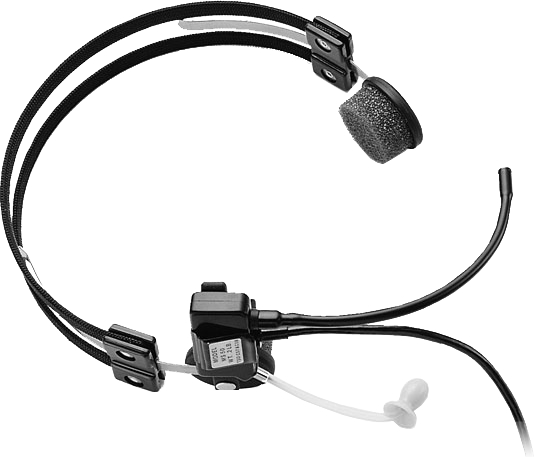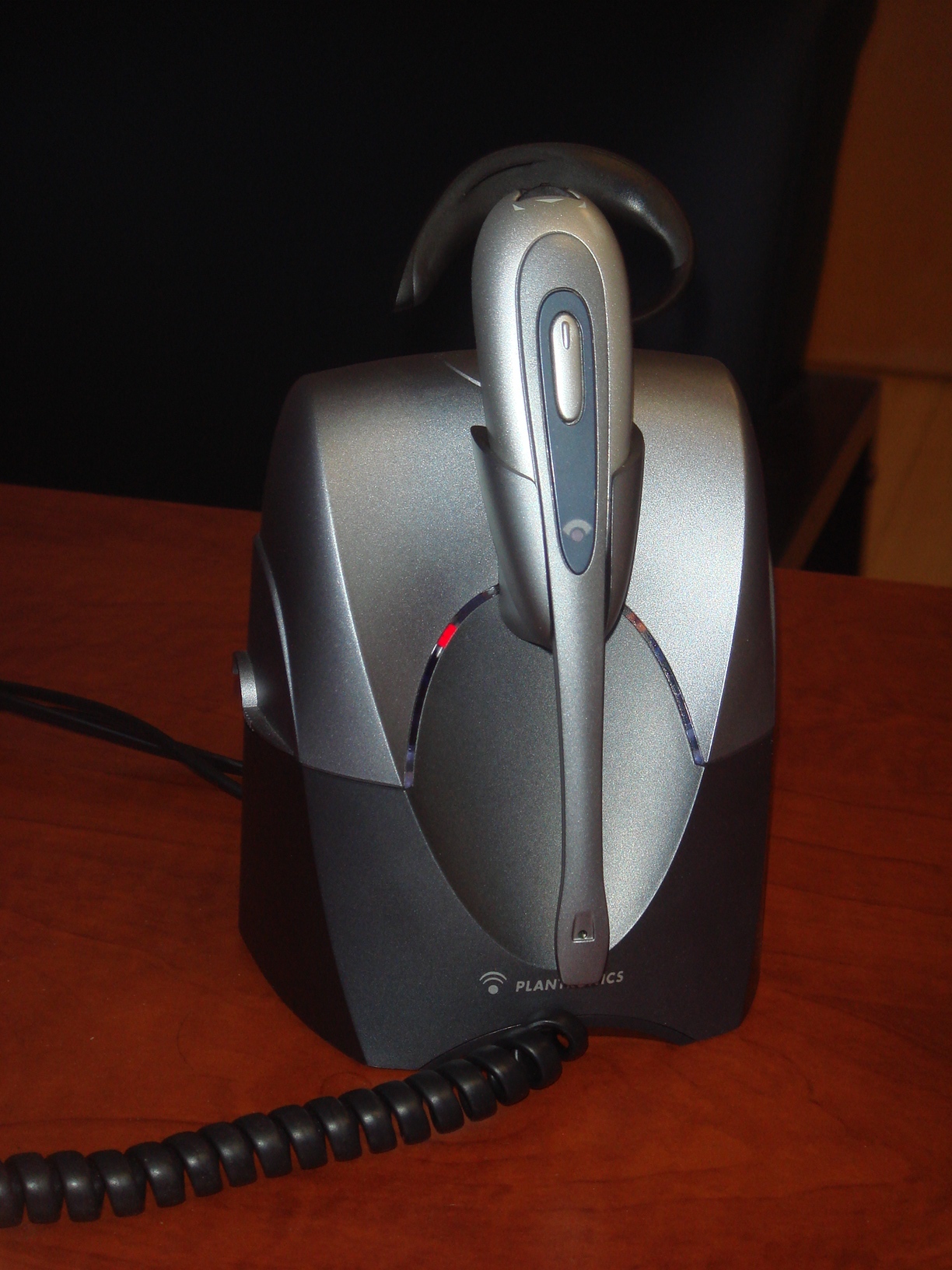Plantronics headset.jpg on:
[Wikipedia]
[Google]
[Amazon]
Plantronics, Inc. is an American electronics company — branded Poly to reflect its dual Plantronics and Polycom heritage — producing audio communications equipment for business and consumers. Its products support
 In the early 1960s, airline headset (audio), headsets were so large and cumbersome that many pilots had switched back to the use of handheld microphones for communications. The speed and complexity of jet airliners caused a need for the introduction of small, lightweight headsets into the cockpit. In 1961, United Airlines solicited new designs from anyone who was interested. Courtney Graham, a United Airlines pilot, was one of the many who thought the heavy headsets should be replaced by something lighter. He collaborated with his pilot friend Keith Larkin to create a small, functional design which was robust enough to pass airlines standards. (Larkin had been working for a small company called Plane-Aids, a Japanese import company which offered spectacles and sunglasses that contained transistor radios in their temple pieces.) The final design, incorporating two small hearing aid-style transducers attached to a headband was submitted to United Airline approval. UAL's approval of the innovative design caused Graham and Larkin to incorporate as Pacific Plantronics (now called Plantronics, Inc.) on May 18, 1961. They introduced the first lightweight communications headset, the MS-50, to the commercial marketplace in 1962.
In the mid-1960s, the Federal Aviation Agency selected Plantronics as the sole supplier of headsets for air traffic controllers, and thereafter was selected to supply headsets to the operators of the Bell Telephone Company, Bell Telephone company.
In the early 1960s, airline headset (audio), headsets were so large and cumbersome that many pilots had switched back to the use of handheld microphones for communications. The speed and complexity of jet airliners caused a need for the introduction of small, lightweight headsets into the cockpit. In 1961, United Airlines solicited new designs from anyone who was interested. Courtney Graham, a United Airlines pilot, was one of the many who thought the heavy headsets should be replaced by something lighter. He collaborated with his pilot friend Keith Larkin to create a small, functional design which was robust enough to pass airlines standards. (Larkin had been working for a small company called Plane-Aids, a Japanese import company which offered spectacles and sunglasses that contained transistor radios in their temple pieces.) The final design, incorporating two small hearing aid-style transducers attached to a headband was submitted to United Airline approval. UAL's approval of the innovative design caused Graham and Larkin to incorporate as Pacific Plantronics (now called Plantronics, Inc.) on May 18, 1961. They introduced the first lightweight communications headset, the MS-50, to the commercial marketplace in 1962.
In the mid-1960s, the Federal Aviation Agency selected Plantronics as the sole supplier of headsets for air traffic controllers, and thereafter was selected to supply headsets to the operators of the Bell Telephone Company, Bell Telephone company.
 Together, SPENCOMM and NASA spent only 11 days to create a working microphone design for space communications and Schirra was the first to use the new communication technology during the Mercury-Atlas 8 mission. Significant redundancy was built into these headsets, as each microphone circuit had two transducers and each receiver had five transducers—in addition, the headsets were used in pairs. The use of these SPENCOMM-NASA headsets in astronaut space suits continued through the remainder of the Mercury program, the Project Apollo, Apollo program and on to this day. The words spoken by U.S. astronaut Neil Armstrong as he stepped on the moon were transmitted through a Plantronics headset.
Together, SPENCOMM and NASA spent only 11 days to create a working microphone design for space communications and Schirra was the first to use the new communication technology during the Mercury-Atlas 8 mission. Significant redundancy was built into these headsets, as each microphone circuit had two transducers and each receiver had five transducers—in addition, the headsets were used in pairs. The use of these SPENCOMM-NASA headsets in astronaut space suits continued through the remainder of the Mercury program, the Project Apollo, Apollo program and on to this day. The words spoken by U.S. astronaut Neil Armstrong as he stepped on the moon were transmitted through a Plantronics headset.

 In the 1980s, Plantronics created a line of cordless products using infrared technology. Though the technology utilized was the same one being used by television remote controls, the link did not require a Federal Communications Commission (FCC) telecommunications approval. One of the first products used the infrared beam to create a communications link between a small transmitter and a base unit which was connected to the telephone network. This product was the first "echo-free" speakerphone for use in conference rooms. The small transmitter could be handheld or clipped to clothing to ensure a good pickup of the speaker's voice.
In the 1980s, Plantronics created a line of cordless products using infrared technology. Though the technology utilized was the same one being used by television remote controls, the link did not require a Federal Communications Commission (FCC) telecommunications approval. One of the first products used the infrared beam to create a communications link between a small transmitter and a base unit which was connected to the telephone network. This product was the first "echo-free" speakerphone for use in conference rooms. The small transmitter could be handheld or clipped to clothing to ensure a good pickup of the speaker's voice.
 Plantronics manufactures mobile headsets, including a line of Bluetooth headsets for mobile phones. The Pulsar 590, for example, is designed for use with Bluetooth- and A2DP-enabled cellphones.
Plantronics manufactures mobile headsets, including a line of Bluetooth headsets for mobile phones. The Pulsar 590, for example, is designed for use with Bluetooth- and A2DP-enabled cellphones.
File:Armstrong-Spencom01.jpg, NASA Astronaut Neil Armstrong wearing "Snoopy cap" with Plantronics (SPENCOM) headset prior to his Apollo 11 lunar landing in 1969.
File:SPENCOM-Stafford.jpg, NASA Astronaut Tom Stafford wearing "Snoopy" cap with Plantronics (SPENCOM) headset in 1975 (Apollo-Soyuz Mission)
File:SPENCOM-NASA.jpg, Plantronics (SPENCOM) headsets in use by NASA Astronauts Ronald Evans (astronaut), Evans and Eugene Cernan, Cernan, both wearing "Snoopy" caps, aboard the Apollo 17 spacecraft.
unified communications
Unified communications (UC) is a business and marketing concept describing the integration of enterprise communication services such as instant messaging (chat), presence information, voice (including IP telephony), mobility features (including ...
, mobile use, gaming and music. Plantronics is headquartered in Santa Cruz, California
Santa Cruz ( Spanish for "Holy Cross") is the county seat and largest city of Santa Cruz County, in Northern California. As of the 2020 census, the city population was 62,956. Situated on the northern edge of Monterey Bay, Santa Cruz is a po ...
, and most of its products are produced in China and Mexico
Mexico (Spanish: México), officially the United Mexican States, is a country in the southern portion of North America. It is bordered to the north by the United States; to the south and west by the Pacific Ocean; to the southeast by Guatema ...
.
On March 18, 2019, Plantronics announced that it would change its name to Poly following its acquisition of Polycom, although it continues to trade on the New York Stock Exchange
The New York Stock Exchange (NYSE, nicknamed "The Big Board") is an American stock exchange in the Financial District of Lower Manhattan in New York City. It is by far the world's largest stock exchange by market capitalization of its listed ...
as Plantronics, Inc. (POLY; listed as PLT until May 24, 2021).
On March 28, 2022, HP Inc.
HP Inc. is an American multinational information technology company headquartered in Palo Alto, California, that develops personal computers (PCs), printers and related supplies, as well as 3D printing solutions.
It was formed on Novembe ...
announced its intent to acquire Poly for $1.7 billion in cash as it looks to bolster its hybrid work offerings, such as headsets and videoconferencing hardware. Including debt, the deal valued at $3.3 billion and closed in August 2022.
History
 In the early 1960s, airline headset (audio), headsets were so large and cumbersome that many pilots had switched back to the use of handheld microphones for communications. The speed and complexity of jet airliners caused a need for the introduction of small, lightweight headsets into the cockpit. In 1961, United Airlines solicited new designs from anyone who was interested. Courtney Graham, a United Airlines pilot, was one of the many who thought the heavy headsets should be replaced by something lighter. He collaborated with his pilot friend Keith Larkin to create a small, functional design which was robust enough to pass airlines standards. (Larkin had been working for a small company called Plane-Aids, a Japanese import company which offered spectacles and sunglasses that contained transistor radios in their temple pieces.) The final design, incorporating two small hearing aid-style transducers attached to a headband was submitted to United Airline approval. UAL's approval of the innovative design caused Graham and Larkin to incorporate as Pacific Plantronics (now called Plantronics, Inc.) on May 18, 1961. They introduced the first lightweight communications headset, the MS-50, to the commercial marketplace in 1962.
In the mid-1960s, the Federal Aviation Agency selected Plantronics as the sole supplier of headsets for air traffic controllers, and thereafter was selected to supply headsets to the operators of the Bell Telephone Company, Bell Telephone company.
In the early 1960s, airline headset (audio), headsets were so large and cumbersome that many pilots had switched back to the use of handheld microphones for communications. The speed and complexity of jet airliners caused a need for the introduction of small, lightweight headsets into the cockpit. In 1961, United Airlines solicited new designs from anyone who was interested. Courtney Graham, a United Airlines pilot, was one of the many who thought the heavy headsets should be replaced by something lighter. He collaborated with his pilot friend Keith Larkin to create a small, functional design which was robust enough to pass airlines standards. (Larkin had been working for a small company called Plane-Aids, a Japanese import company which offered spectacles and sunglasses that contained transistor radios in their temple pieces.) The final design, incorporating two small hearing aid-style transducers attached to a headband was submitted to United Airline approval. UAL's approval of the innovative design caused Graham and Larkin to incorporate as Pacific Plantronics (now called Plantronics, Inc.) on May 18, 1961. They introduced the first lightweight communications headset, the MS-50, to the commercial marketplace in 1962.
In the mid-1960s, the Federal Aviation Agency selected Plantronics as the sole supplier of headsets for air traffic controllers, and thereafter was selected to supply headsets to the operators of the Bell Telephone Company, Bell Telephone company.
SPENCOMM and NASA
In 1961, NASA astronaut Wally Schirra contacted Courtney Graham, a fellow pilot, to discuss creating a design for a small, lightweight headset to be used in the Project Mercury, Mercury spacecraft. Pacific Plantronics assembled its Space Environmental Communications (SPENCOMM) division to begin working on a reliable solution. SPENCOMM personnel traveled to NASA's Manned Spacecraft Center (now Lyndon B. Johnson Space Center, Johnson Space Center) and Kennedy Space Center to meet with and get design feedback from Schirra and several other astronauts, including Gordon Cooper. Together, SPENCOMM and NASA spent only 11 days to create a working microphone design for space communications and Schirra was the first to use the new communication technology during the Mercury-Atlas 8 mission. Significant redundancy was built into these headsets, as each microphone circuit had two transducers and each receiver had five transducers—in addition, the headsets were used in pairs. The use of these SPENCOMM-NASA headsets in astronaut space suits continued through the remainder of the Mercury program, the Project Apollo, Apollo program and on to this day. The words spoken by U.S. astronaut Neil Armstrong as he stepped on the moon were transmitted through a Plantronics headset.
Together, SPENCOMM and NASA spent only 11 days to create a working microphone design for space communications and Schirra was the first to use the new communication technology during the Mercury-Atlas 8 mission. Significant redundancy was built into these headsets, as each microphone circuit had two transducers and each receiver had five transducers—in addition, the headsets were used in pairs. The use of these SPENCOMM-NASA headsets in astronaut space suits continued through the remainder of the Mercury program, the Project Apollo, Apollo program and on to this day. The words spoken by U.S. astronaut Neil Armstrong as he stepped on the moon were transmitted through a Plantronics headset.
MS-50
Following the Pacific Plantronics partnership with NASA in the Space Program, the MS-50 headset gained recognition in the communication marketplace. The FAA, Western Electric, and companies with telephone call centers adapted the MS-50 as a replacement for existing headsets. On May 18, 1965, U.S. Pat. No. 3,184,556 was issued to W. K. Larkin for a
StarSet
In 1970, Ken Hutchings, an engineer who had joined Pacific Plantronics, patented a device which was marketed as the "StarSet". United States Patent 3548118 describesWireless products
Wireless office headsets
In 2003, Plantronics introduced the CS50 wireless headset for use on office phones. Since that time, Plantronics has manufactured other wireless headsets, including the "CS70N", CS500 Series, and Savi 700 Series. In recent years there has also been strong focus on Unified Communications headsets and speakers.Mobile and Bluetooth mobile headsets
 Plantronics manufactures mobile headsets, including a line of Bluetooth headsets for mobile phones. The Pulsar 590, for example, is designed for use with Bluetooth- and A2DP-enabled cellphones.
Plantronics manufactures mobile headsets, including a line of Bluetooth headsets for mobile phones. The Pulsar 590, for example, is designed for use with Bluetooth- and A2DP-enabled cellphones.
Computer and gaming headsets
Plantronics manufactured headsets for PC audio and online and console gaming via its GameCom and .Audio and RIG Gaming labels. Plantronics entered the multimedia headset market in 1999 with the release of the HS1 and the DSP-500 headsets, the latter featuring a built-in digital signal processing card. In 2002, Plantronics and Microsoft created the headset for the Xbox (console), Xbox Communicator, the first headset to enable voice communication with Xbox Live. The company created a special headset for the Xbox (console), Xbox as a tie-in with the videogame ''Halo 2'' in 2004. Plantronics exited the gaming and consumer markets in 2019, focusing on enterprise collaboration with its Poly brand.Corporate expansion and acquisitions
Plantronics has expanded into other segments of the audio equipment market through acquisitions.Clarity
In 1986, Plantronics acquired Walker Equipment, Ringgold, Georgia, a manufacturer of electronic amplifier, amplified handsets and telephones. The Clarity products were created to enhance telephone usability for those with hearing impairment. Walker later acquired Ameriphone in 2002, and became Walker Ameriphone before changing its name to Clarity; Clarity is now a US supplier of amplified telephones. In February 2015, Plantronics released the Clarity 340 handset style phone for UC communications.Altec Lansing
In 2005, Plantronics acquired computer speaker manufacturer Altec Lansing for approximately $166 million. In spite of a corporate makeover the brand continued to struggle and was acquired by Profit Equity in October 2009 for approximately $18 million.Volume Logic
Plantronics later acquired Octiv, Inc. in March 2005 as one of its brands and renamed it as the Volume Logic division. Octiv produced an audio toolset for creating 5.1 surround sound soundtracks. Although the Volume Logic series of applications have since been discontinued, the underlying technology has been adapted for use in Plantronics telephony products.Polycom
On March 28, 2018, Plantronics announced it would acquire Polycom for approximately $2 billion.2005 to present
In October 2016, long-time chief executive Kenneth Kannappan, S. Kenneth Kannappan retired and was replaced by Joe Burton, who had joined in 2011. On February 10, 2020, Plantronics announced the appointment of Robert Hagerty as interim CEO, replacing Joe Burton.Gallery
References
Further reading
* * * * *External links
* {{Authority control 1961 establishments in California American companies established in 1961 Audio equipment manufacturers of the United States Bluetooth Companies based in Santa Cruz, California Companies formerly listed on the New York Stock Exchange Electronics companies established in 1961 Headphones manufacturers Manufacturing companies based in California 2022 mergers and acquisitions Hewlett-Packard acquisitions